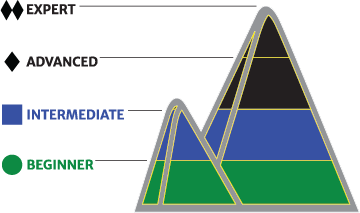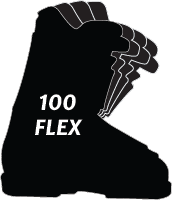product specs
Condition:
 More Info
More Info
Condition

Well Loved - A well loved boot shows significant signs of wear and tear including heel wear, scratching, and scuffing on a majority of the boot’s surface area.
Fair - A fair boot shows some signs of wear and tear on the sole of the boot. This includes chipping, scratching and scuffing on high impact areas like the heel and toe lugs. The liners in these boots are typically very broken in.
Good - A good boot shows minor signs of wear and tear with little heel and toe wear, some minor cosmetic scratches across both boots, but no major damage. Liners in these boots have been broken in but still have some life left in them.
Excellent - An excellent boot shows almost no signs of wear and tear on the sole or upper of the boot shell. The liners in these boots show little signs of break in and will fit tighter than a boot that has been used more.
Terrain:
All_Mountain More Info
More Info
terrain

Groomers - Though it is rare a boot is designed for one sole terrain type, boots that are categorized for groomers are generally designed for more beginner to intermediate skiers. Boots in this category are generally a soft to medium flex with the exception of race ski boots which are generally stiffer.

All Mountain - Most boots are classified as All Mountain. This category covers the widest range of volume, flex and performance. These boots are made to ski various types of terrain and surfaces.

Freestyle - Freestyle boots are generally made to be light and nimble when performing tricks. This style of boot usually has a medium flex.

Big Mountain/Powder - Boots for big mountain/powder skiing are stiffer in nature and provide a higher performance fit. Stiffness creates the support you need when skiing at high speeds or through rough, variable terrain.

Backcountry - Backcountry boots are built for skiing as well as touring uphill. They are built with lighter constructions and offer closure systems that are meant to reduce weight compared to an alpine ski boot. These boots generally feature a walk mode which allows the boot to flex backwards, creating a more natural stride pattern when skinning uphill. A majority of backcountry boots also feature tech inserts in the toe and heel of the boot to accommodate a pin style binding.
Ability Level:
Beginner-Advanced More Info
More Info
Ability Level

Beginner - Skis, Boards, Boots and Bindings for the beginner skier or boarder are built to be more forgiving and easier to handle on the slopes. Skis and Boards are typically built with foam or wood cores that are more flexible and have shorter radii, making them less challenging to turn. Bindings are generally more pliable than models built for more advanced skiers or boarders.
Intermediate - Skis, Boards, Boots and Bindings for intermediate skiers or boarders generally provide more stability and performance than beginner focused equipment. Skis and Boards generally have medium radiuses with better handling at higher speed while still being forgiving at slower speeds.
Advanced - Skis, Boards, Boots and Bindings for advanced skiers or boarders generally provide a stiffer, higher performance ride that is better suited for steeper terrain and higher speeds. Skis and Boards generally have medium to large radii. Bindings are generally more rigid and provide better power transfer.
Expert - Skis, Boards, Boots and Bindings for expert skiers or boarders are built to provide the highest level of precision and power. Skis and Boards are generally on the stiffer side requiring more effort and technique to turn effectively.
Flex:
 More Info
More Info
Flex

The flex of a ski boot is the measure of force required to bend the boot at the ankle. The stiffer the boot is, the more support it provides. A stiffer boot requires the skier to stand with their weight further forward in order to transfer energy through the boot to the ski effectively. Softer, more forgiving boots are meant for less experienced or lighter skiers. A softer boot requires less energy to initiate the turn of the ski.
Ski boot flex ranges from about 40 (for small children) up to 130 for general consumer boots. An 85 flex is generally a medium stiffness for intermediate women skiers, and a 100 flex is a generally a medium stiffness for intermediate men. Some race boots, categorized as “world cup flex” are measured at 140-170 flex and are built for only the most aggressive skiers. Ultimately, the flex index is not a perfectly succinct measurement across boot brands; it is always best to try a boot on before buying to confirm the flex works well for you.
2022 Lange Starlet 50 JR Ski Boot
product specs
Condition:
 More Info
More Info
Condition

Well Loved - A well loved boot shows significant signs of wear and tear including heel wear, scratching, and scuffing on a majority of the boot’s surface area.
Fair - A fair boot shows some signs of wear and tear on the sole of the boot. This includes chipping, scratching and scuffing on high impact areas like the heel and toe lugs. The liners in these boots are typically very broken in.
Good - A good boot shows minor signs of wear and tear with little heel and toe wear, some minor cosmetic scratches across both boots, but no major damage. Liners in these boots have been broken in but still have some life left in them.
Excellent - An excellent boot shows almost no signs of wear and tear on the sole or upper of the boot shell. The liners in these boots show little signs of break in and will fit tighter than a boot that has been used more.
Terrain:
All_Mountain More Info
More Info
terrain

Groomers - Though it is rare a boot is designed for one sole terrain type, boots that are categorized for groomers are generally designed for more beginner to intermediate skiers. Boots in this category are generally a soft to medium flex with the exception of race ski boots which are generally stiffer.

All Mountain - Most boots are classified as All Mountain. This category covers the widest range of volume, flex and performance. These boots are made to ski various types of terrain and surfaces.

Freestyle - Freestyle boots are generally made to be light and nimble when performing tricks. This style of boot usually has a medium flex.

Big Mountain/Powder - Boots for big mountain/powder skiing are stiffer in nature and provide a higher performance fit. Stiffness creates the support you need when skiing at high speeds or through rough, variable terrain.

Backcountry - Backcountry boots are built for skiing as well as touring uphill. They are built with lighter constructions and offer closure systems that are meant to reduce weight compared to an alpine ski boot. These boots generally feature a walk mode which allows the boot to flex backwards, creating a more natural stride pattern when skinning uphill. A majority of backcountry boots also feature tech inserts in the toe and heel of the boot to accommodate a pin style binding.
Ability Level:
Beginner-Advanced More Info
More Info
Ability Level

Beginner - Skis, Boards, Boots and Bindings for the beginner skier or boarder are built to be more forgiving and easier to handle on the slopes. Skis and Boards are typically built with foam or wood cores that are more flexible and have shorter radii, making them less challenging to turn. Bindings are generally more pliable than models built for more advanced skiers or boarders.
Intermediate - Skis, Boards, Boots and Bindings for intermediate skiers or boarders generally provide more stability and performance than beginner focused equipment. Skis and Boards generally have medium radiuses with better handling at higher speed while still being forgiving at slower speeds.
Advanced - Skis, Boards, Boots and Bindings for advanced skiers or boarders generally provide a stiffer, higher performance ride that is better suited for steeper terrain and higher speeds. Skis and Boards generally have medium to large radii. Bindings are generally more rigid and provide better power transfer.
Expert - Skis, Boards, Boots and Bindings for expert skiers or boarders are built to provide the highest level of precision and power. Skis and Boards are generally on the stiffer side requiring more effort and technique to turn effectively.
Flex:
 More Info
More Info
Flex

The flex of a ski boot is the measure of force required to bend the boot at the ankle. The stiffer the boot is, the more support it provides. A stiffer boot requires the skier to stand with their weight further forward in order to transfer energy through the boot to the ski effectively. Softer, more forgiving boots are meant for less experienced or lighter skiers. A softer boot requires less energy to initiate the turn of the ski.
Ski boot flex ranges from about 40 (for small children) up to 130 for general consumer boots. An 85 flex is generally a medium stiffness for intermediate women skiers, and a 100 flex is a generally a medium stiffness for intermediate men. Some race boots, categorized as “world cup flex” are measured at 140-170 flex and are built for only the most aggressive skiers. Ultimately, the flex index is not a perfectly succinct measurement across boot brands; it is always best to try a boot on before buying to confirm the flex works well for you.





